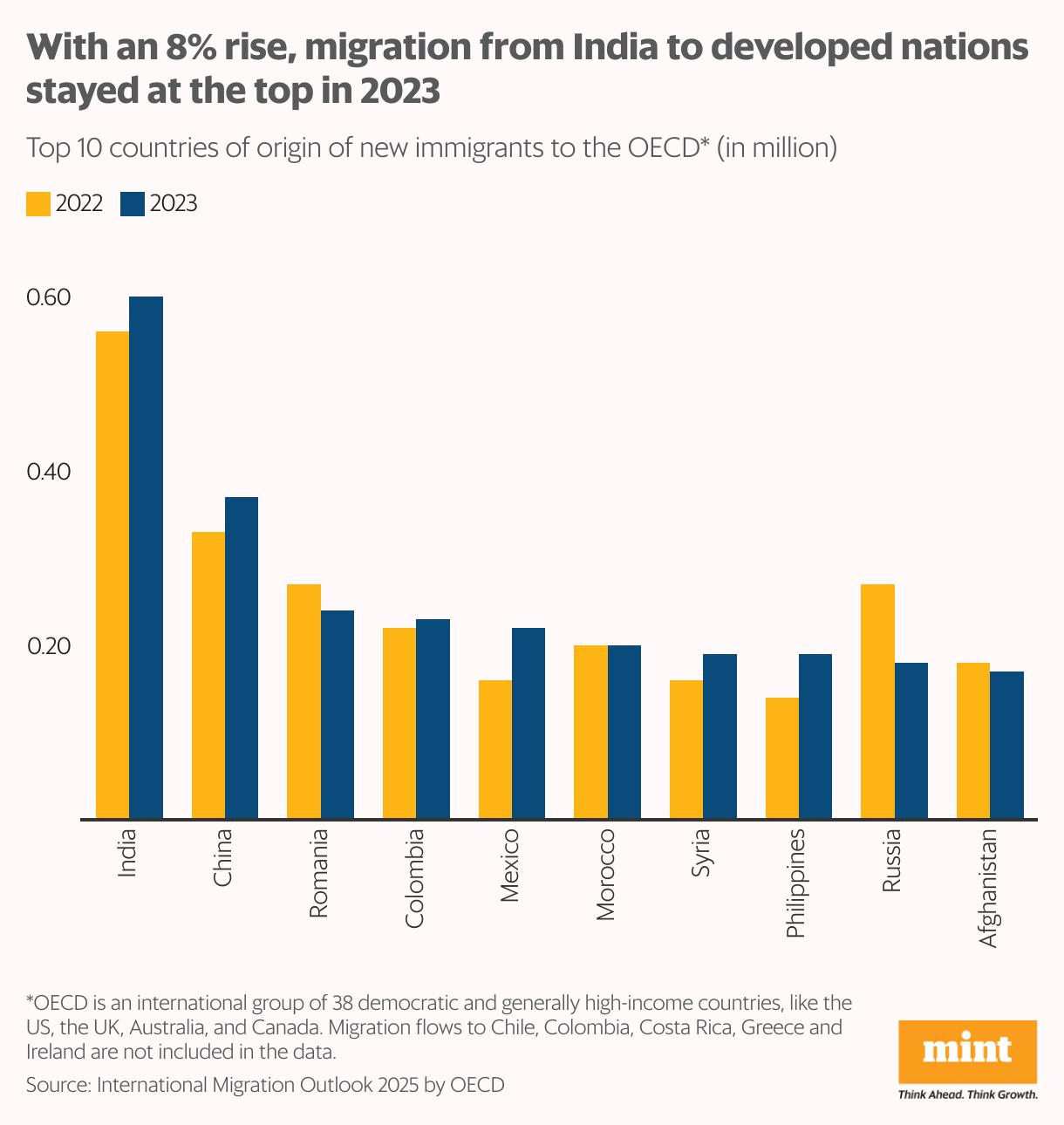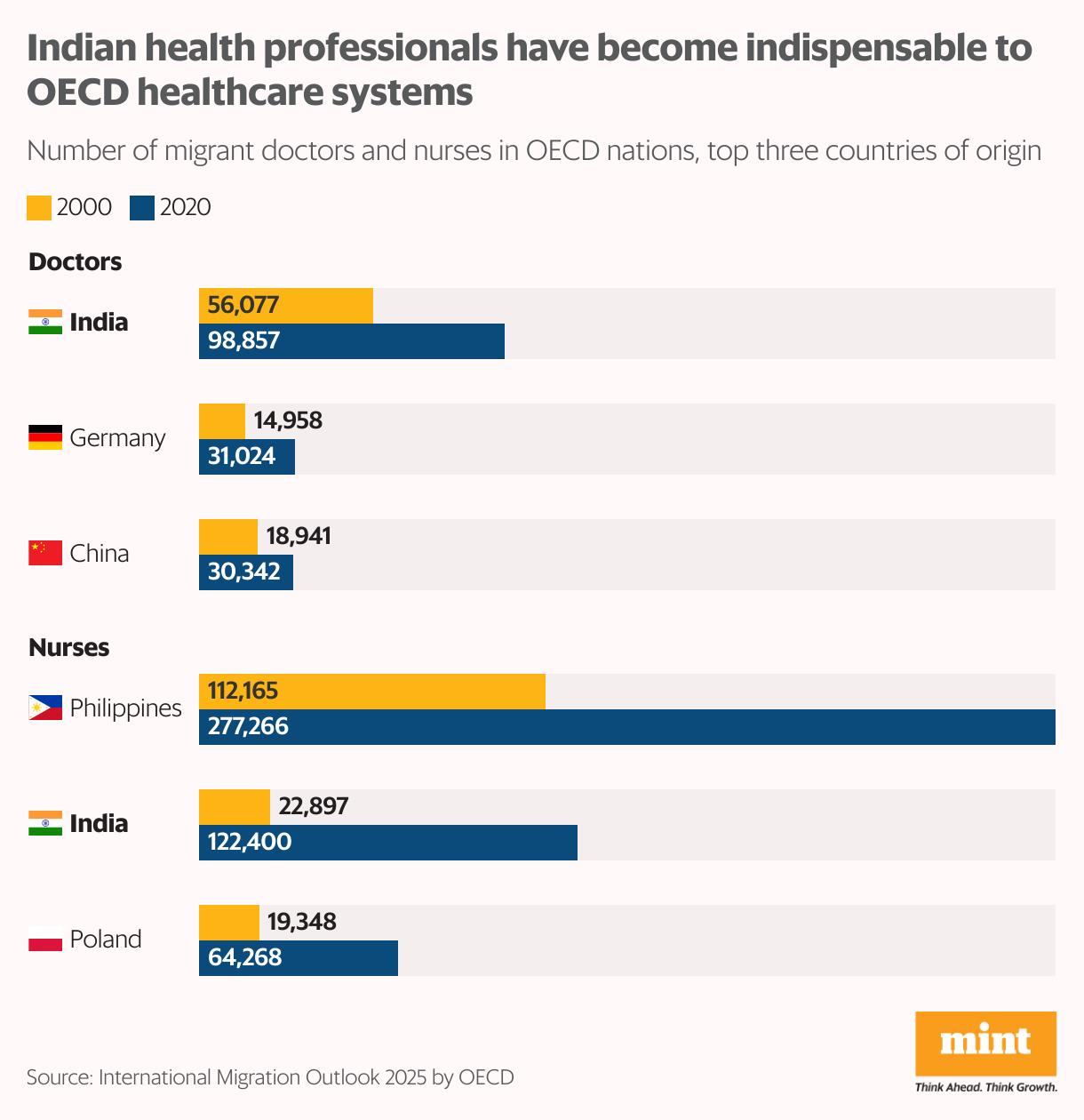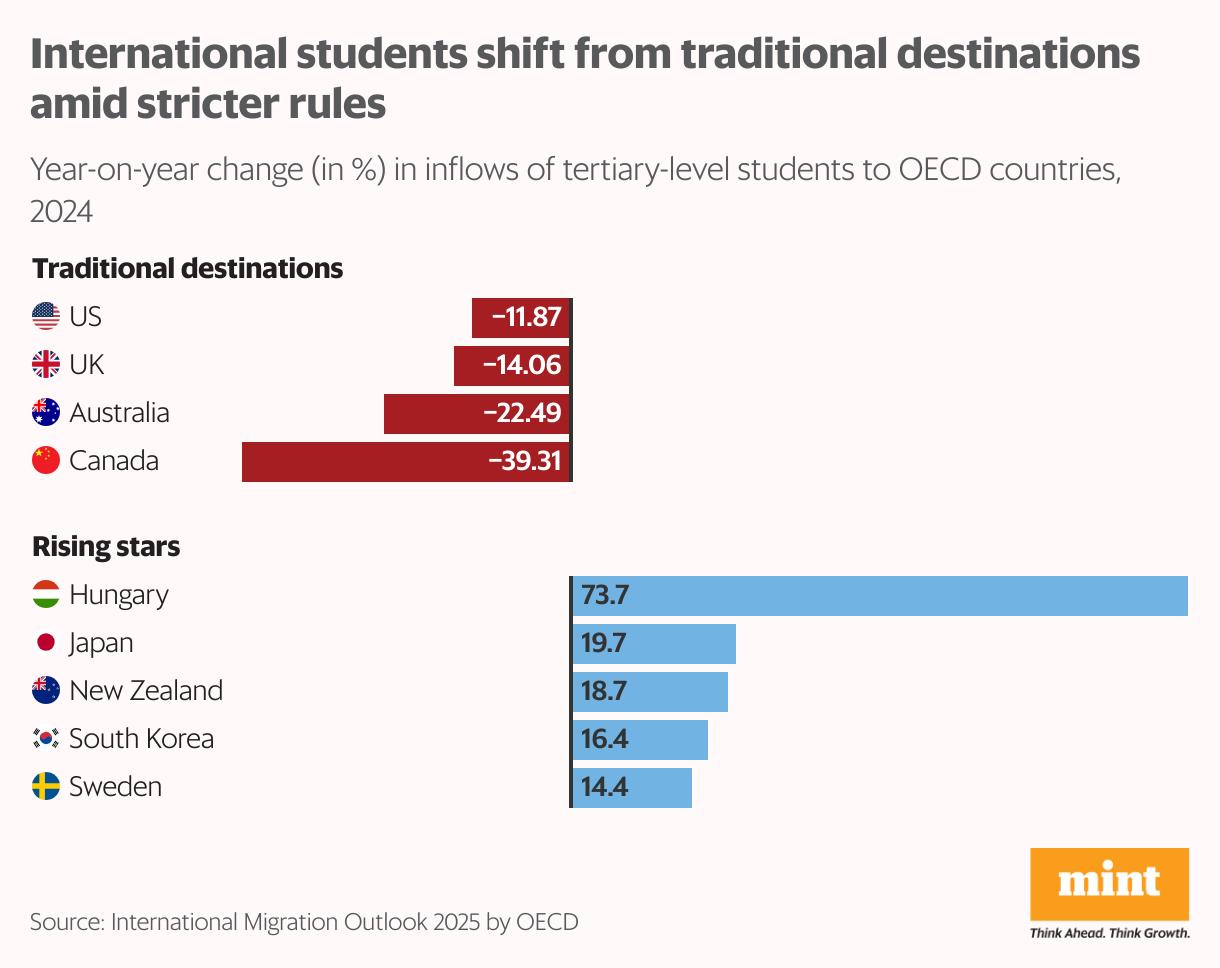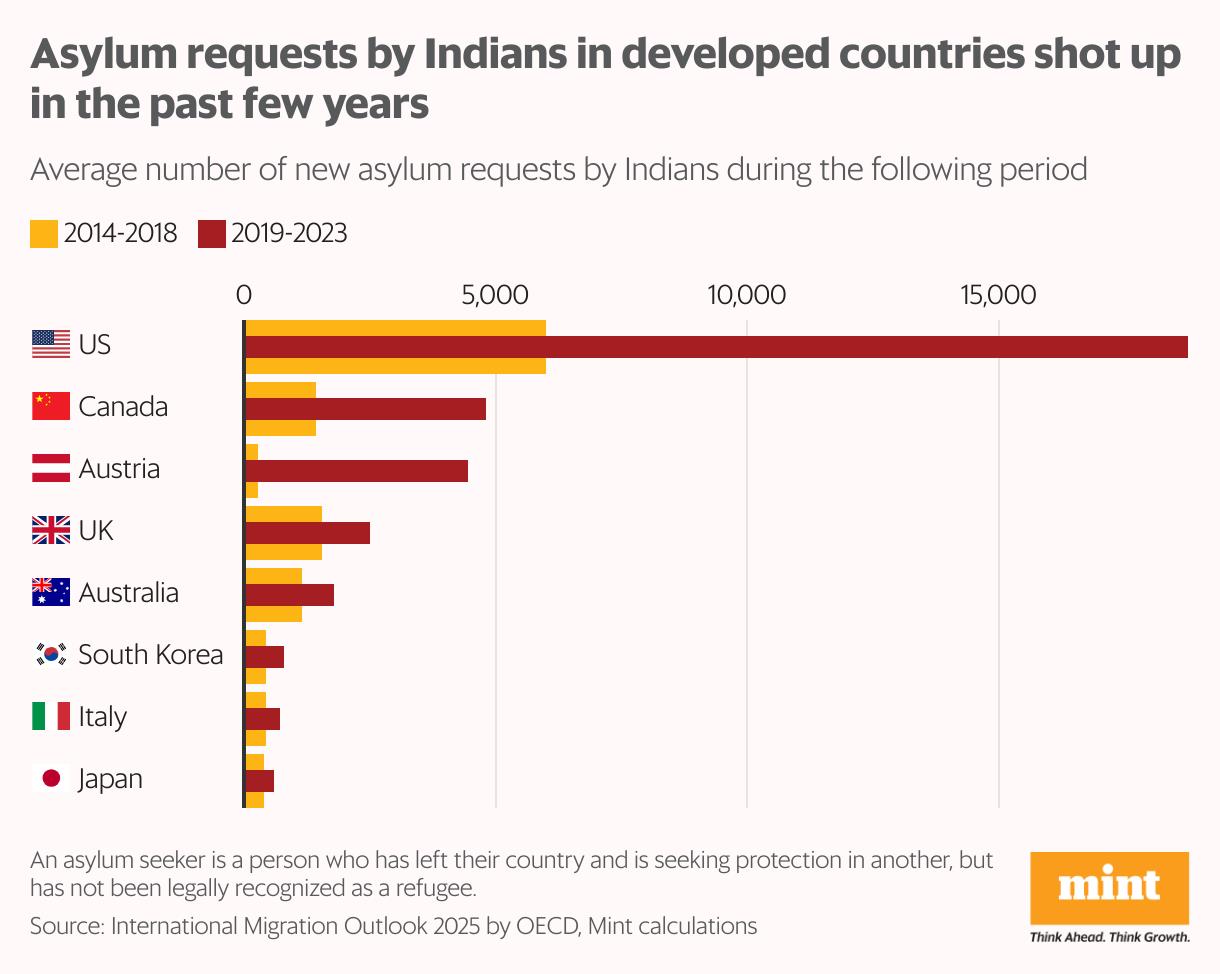
Migration Trends Shift: India Stays Ahead In Flows To Developed Nations, China Overtakes In Student Visas
India has remained a leading source of immigrants to developed countries ever since it displaced China during the pandemic, according to a recent report by the Organization for Economic Co-operation and Development (OECD).
The 2025 edition of the International Migration Outlook said India consolidated its position in 2023 and held a clear lead over all other origin countries in migration to a group of 38 OECD countries, such as the US, the UK, Canada and Australia.
However, the report also pointed to various shifts that are underway: India lost its top country status in 2024 in terms of international student migration to the US and the UK, while China took the lead.
On the other hand, continued high demand for healthcare professionals propelled significant migration from India. Mint explores the key trends:
At the top
Over 600,000 Indians moved to OECD nations in 2023, an 8.1% rise compared to the previous year. This is over 1.5 times the 368,000 migration from China.
The report pointed out that India and China have long been the top sources of migrants to OECD countries, outside humanitarian crises. Since the covid pandemic, India has surpassed China as the largest source of migrants and has held on to that lead.

Traditionally, Australia, Canada, the UK and the US have been the top destinations for Indian migration. In 2023, one in four Indians chose the UK (144,000), recording a rise of 28% from the previous year.
However, even before Donald Trump's protectionist policies, immigration to the US - the world's largest economy - declined by 45% to 68,000, showing a sharp contrast with other top nations. This trend is likely to worsen with stricter policies by the current administration.
Citizenship countAccording to the latest data from the report, 225,000 Indians acquired citizenship in OECD countries in 2023, the highest among all countries. War-torn Syria was a distant second at 150,000. In absolute terms, Canada, the US, Australia and the UK were the top choices, accounting for 84.2% of total Indian naturalisations in OECD nations.

A country-wise analysis by Mint showed that over time, Australia and Canada have emerged as the most generous destinations, offering the largest shares of their total citizenships to Indians. Australia's share rose to 21% in 2023, up from 15.6% in 2013.
Also Read | Skills mismatch, migration to metros hurting recruitments in small cit
Canada saw a similar surge, with nearly one-fifth of its new citizens being of Indian origin-almost double the proportion a decade ago. The share of citizenships offered to Indians by the UK, on the other hand, has fallen sharply from nearly 18% a decade ago to about 9% in 2023. Indians' share of citizenship in the US-the most sought-after destination-has remained stagnant at 6-7%.
Powering critical sectors
Indian talent has been in high demand in many developed countries, which are struggling with an ageing population and labour shortages. One such critical sector is healthcare. India has consistently been a key source of healthcare professionals, providing the highest number of doctors and the second-highest number of nurses to OECD countries. Of the 600,000 that migrated to these countries in 2023, 97,000 (one in six) had a health and care worker visa.

More detailed data, which allows for comparison with other source countries, is available for 2020, which puts India among the top three. In 2020, nearly 830,000 doctors and 1.75 million nurses working in the OECD were foreign-born.
Of these, 98,857 Indian-born doctors were employed in the OECD, up from 56,077 in 2000. India-born nurses were 122,400 in 2020, up from 22,879 from two decades ago.
Countries such as the UK and Denmark, with ageing populations, have agreements with India for health and social care workforce recruitment.
However, challenges persist over recognition of foreign education credentials and lengthy authorisation processes to start practising in host nations, the report pointed out.
Also Read | Trump's H-1B visa fee hike: the death of ons Changing gearsFor many aspirational skilled migrants, education has long been a gateway to emigrate to advanced economies. That route, however, is hollowing out as top destinations are tightening student visa rules. And the latest numbers bear this out.
In 2024, OECD countries hosted over 1.8 million international students pursuing undergraduate and postgraduate degrees. This is 13% fewer than in 2023 and the first decline since the pandemic, the report pointed out.
The decline was primarily due to decreasing inflows to the top four receiving countries-the US (-12%), the UK (-14%), Canada (-39%), and Australia (-22%).

These traditionally popular destinations remain the top draw among Indian students, before numbers have started to decline now. While high-profile countries are closing their doors, several other countries in the OECD group are welcoming more students, suggesting the shift towards nations with friendlier policies. These include countries like Hungary (73.7%), Japan (19.7%), New Zealand (18.7%) and South Korea (16.4%) that have seen a sharp on-year surge in student inflows in 2024, the data showed.
Asylum surgeAsylum applications from Indians to advanced countries have seen a significant jump in recent years. A Mint analysis of data shows that as of 2023 (the last year for which all-country data is available), out of 38 OECD nations, Indians have filed asylum requests across 15 of them. The post-pandemic period has seen a sharp surge in requests.
The average number of requests jumped 2.9 times between 2019 and 2023 compared to the preceding five-year period. Top countries by number of requests during this period include the US, Canada and the UK.
Also Read | The superpower of Odisha's migrant workers, crafted over a dec
Some countries stood out for their sharp jumps. For instance, Indians' average asylum requests surged over 14 times in Finland and six times in New Zealand. Past research has shown that many Indian asylum seekers are individuals who enter these countries illegally in search of better economic opportunities.
“The vast majority of asylum seekers are economic migrants who face limited economic opportunities at home and thus seek employment opportunities abroad," noted a February 2025 study by researchers from Johns Hopkins University who studied asylum requests by Indians in the US.
Legal Disclaimer:
MENAFN provides the
information “as is” without warranty of any kind. We do not accept
any responsibility or liability for the accuracy, content, images,
videos, licenses, completeness, legality, or reliability of the information
contained in this article. If you have any complaints or copyright
issues related to this article, kindly contact the provider above.

















Comments
No comment